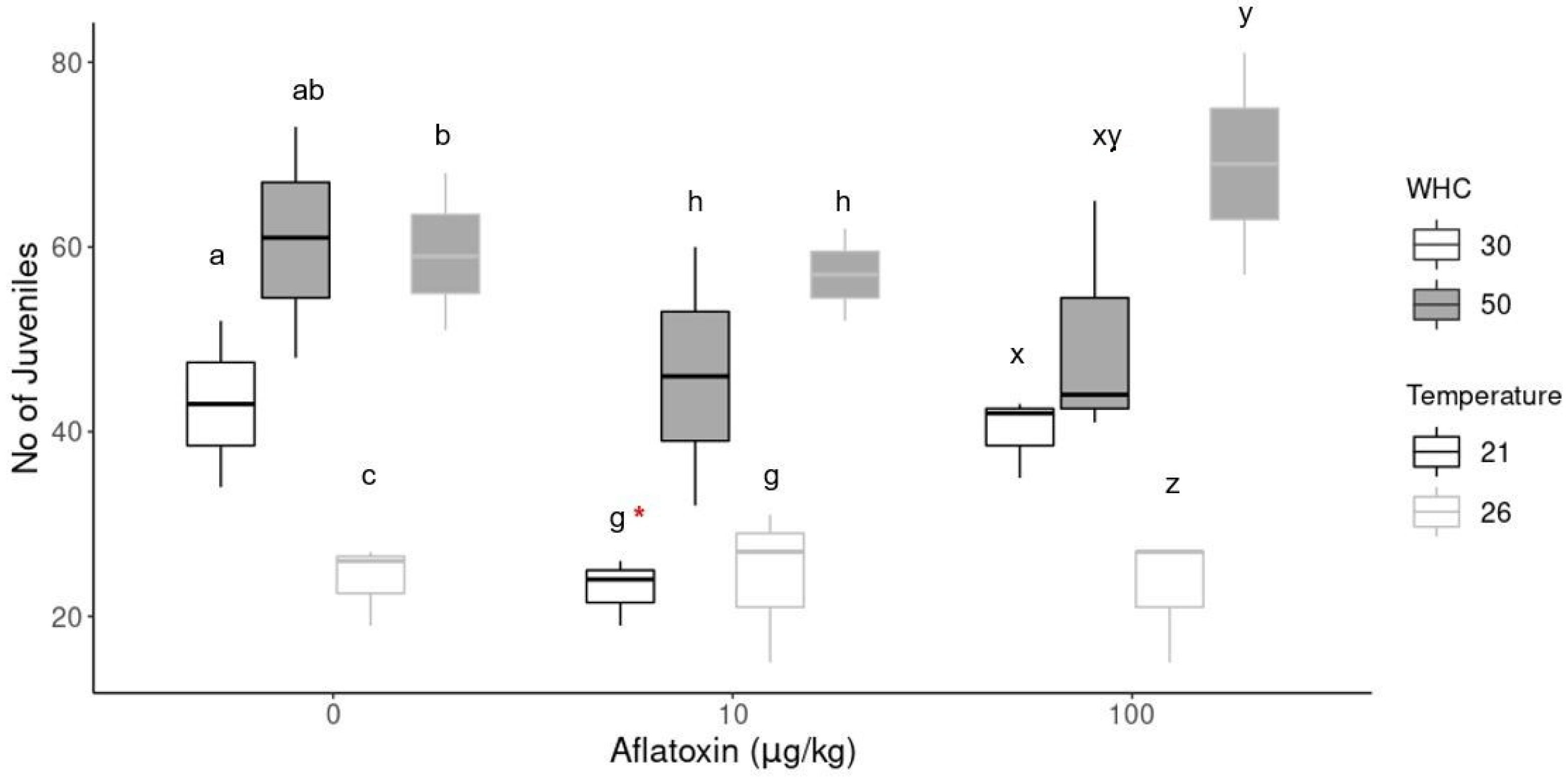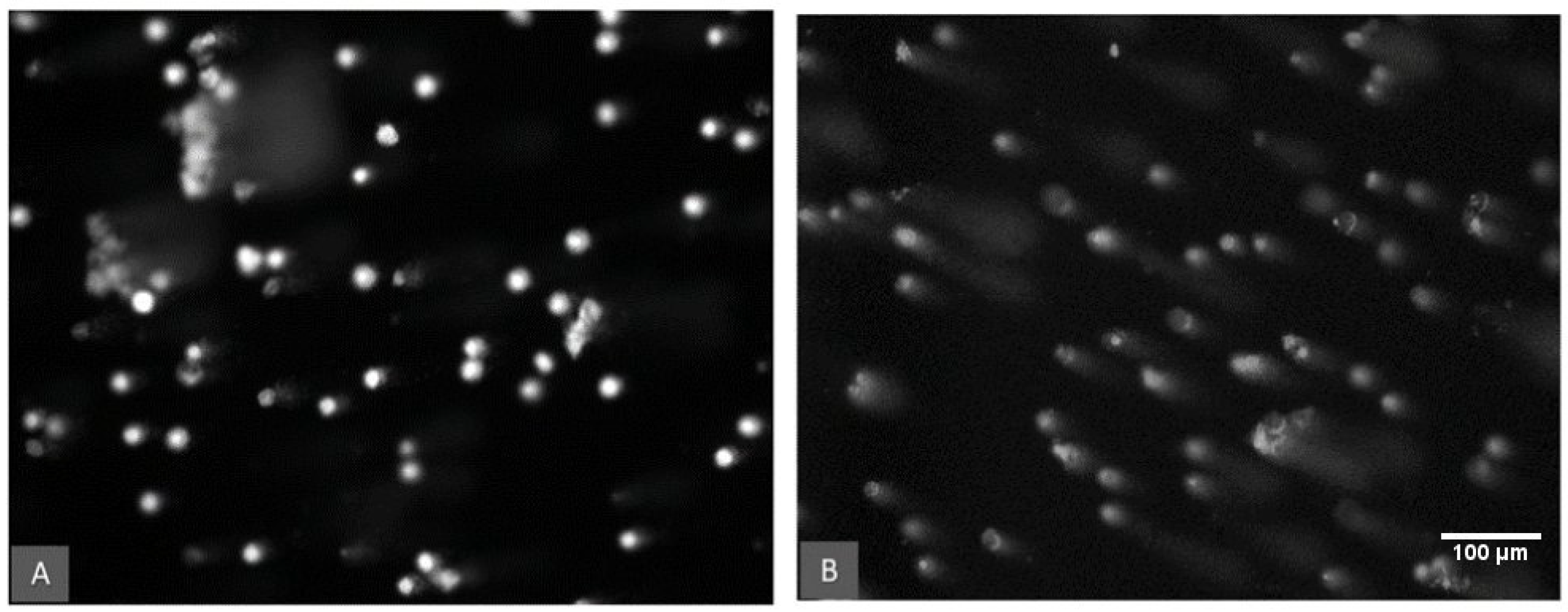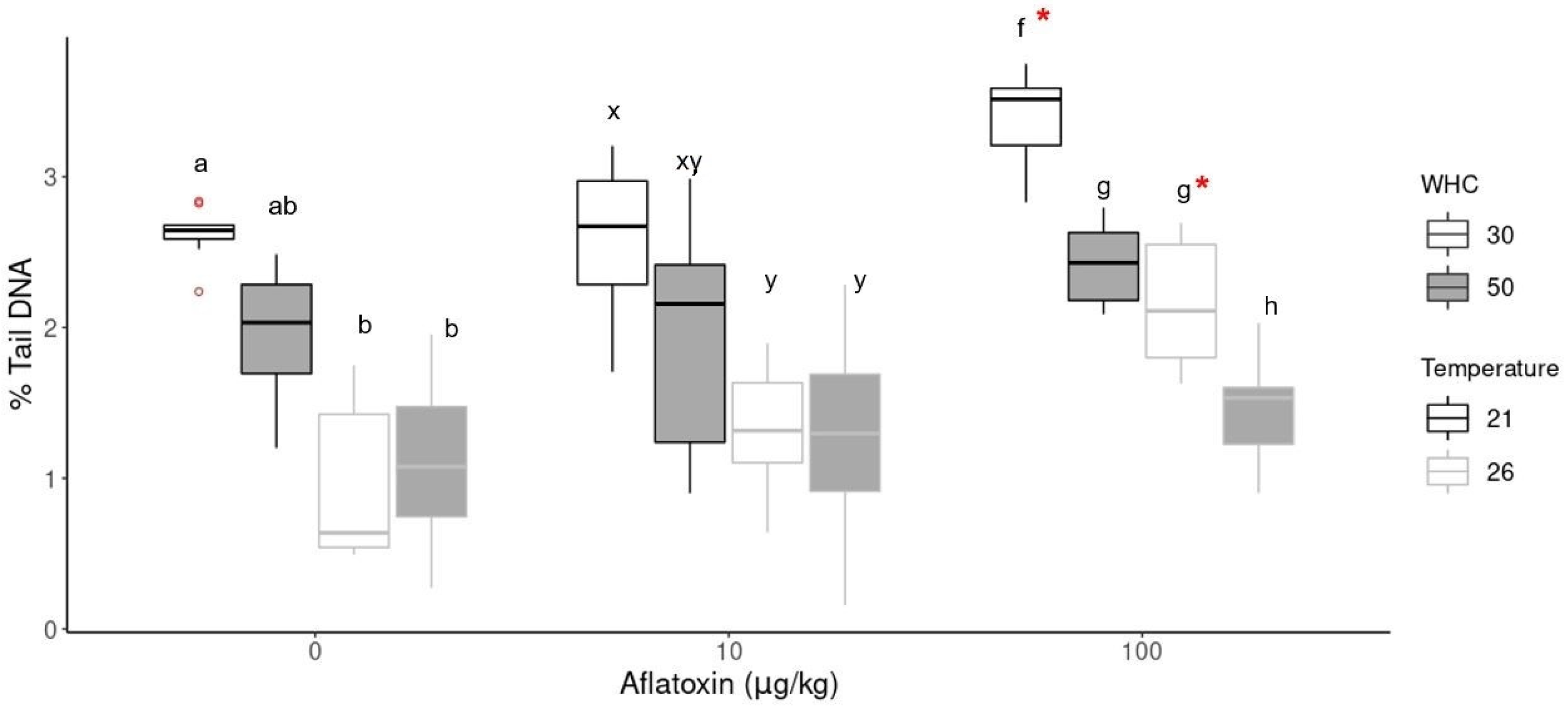Ecotoxicological Effects of Aflatoxins on Earthworms under Different Temperature and Moisture Conditions
Abstract
:1. Introduction
- Assess whether aflatoxin affects earthworms’ demographic processes (survival, growth and reproduction) using a standard OECD test.
- Assess the genotoxicity of aflatoxin to earthworms using the comet assay.
- Assess whether different temperatures (21 °C and 26 °C) and soil moisture conditions (30% and 50% of soil water holding capacity) affect the toxicity of aflatoxins to earthworms.
2. Results
2.1. Aflatoxin Concentrations in the Soil
2.2. Earthworm Survival, Weight Change and Reproduction
2.3. Genotoxicity-Comet Assay Results
2.4. Interaction Effect of Climate Conditions on the Toxicity of Aflatoxin
3. Discussion
4. Conclusions
5. Materials and Methods
5.1. Experimental Design
- 10% sphagnum-peat (Mystics).
- 69% quartz sand with a grain size between 50 and 200 μm.
- 20% kaolinite clay (obtained from Atlas Clay Group in Potchefstroom, South Africa).
- Chemically pure calcium carbonate (<1%) to obtain a pH of 6.5–7.
- 21 ± 1 °C + 50% (WHC)—standard temperature and moisture conditions prescribed by the OECD.
- 21 ± 1 °C + 30% (WHC)—standard temperature with drier soil conditions.
- 26 ± 1 °C + 50% (WHC)—increased temperatures with standard moisture conditions.
- 26 ± 1 °C + 30% (WHC)—increased temperatures with decreased soil moisture conditions.
5.2. Introduction of Aflatoxin into the Soil
5.3. Aflatoxin Concentrations
5.4. Earthworm Survival, Weight and Reproduction Test
5.5. Comet Assay
5.6. Statistical Analysis
Author Contributions
Funding
Institutional Review Board Statement
Informed Consent Statement
Data Availability Statement
Acknowledgments
Conflicts of Interest
References
- Ostry, V.; Malir, F.; Toman, J.; Grosse, Y. Mycotoxins as human carcinogens—The IARC Monographs classification. Mycotoxin Res. 2017, 33, 65–73. [Google Scholar] [CrossRef]
- Theumer, M.G.; Henneb, Y.; Khoury, L.; Snini, S.; Tadrist, S.; Canlet, C.; Puel, O.; Oswald, I.P.; Audebert, M. Genotoxicity of aflatoxins and their precursors in human cells. Toxicol. Lett. 2018, 287, 100–107. [Google Scholar] [CrossRef]
- Mertz, D.; Edward, T.; Lee, D.; Zuber, M. Absorption of aflatoxin by lettuce seedlings grown in soil adulterated with aflatoxin B1. J. Agric. Food Chem. 1981, 29, 1168–1170. [Google Scholar] [CrossRef]
- Hariprasad, P.; Vipin, A.V.; Karuna, S.; Raksha, R.K.; Venkateswaran, G. Natural aflatoxin uptake by sugarcane (Saccharum officinaurum L.) and its persistence in jaggery. Environ. Sci. Pollut. Res. 2014, 22, 6246–6253. [Google Scholar] [CrossRef]
- Corcuera, L.-A.; Vettorazzi, A.; Arbillaga, L.; Pérez, N.; Gil, A.G.; Azqueta, A.; González-Peñas, E.; García-Jalón, J.A.; de Cerain, A.L. Genotoxicity of Aflatoxin B1 and Ochratoxin A after simultaneous application of the in vivo micronucleus and comet assay. Food Chem. Toxicol. 2015, 76, 116–124. [Google Scholar] [CrossRef] [PubMed]
- Lawson, B.; MacDonald, S.; Howard, T.; Macgregor, S.K.; Cunningham, A.A. Exposure of garden birds to aflatoxins in Britain. Sci. Total Environ. 2006, 361, 124–131. [Google Scholar] [CrossRef]
- Azab, S.G.; Sadek, M.M.; Crailsheim, K. Protein metabolism in larvae of the cotton leaf-worm Spodoptera littoralis (Lepidoptera: Noctuidae) and its response to three mycotoxins. Environ. Èntomol. 2001, 30, 817–823. [Google Scholar] [CrossRef]
- Feng, W.-H.; Xue, K.S.; Tang, L.; Williams, P.L.; Wang, J.-S. Aflatoxin B1-Induced Developmental and DNA Damage in Caenorhabditis elegans. Toxins 2016, 9, 9. [Google Scholar] [CrossRef] [PubMed] [Green Version]
- Zhao, X.; Wang, D.; Fields, P.G.; Li, H. Effect of aflatoxin B1 on development, survival and fecundity of Ahasverus advena Waltl. J. Stored. Prod. Res. 2018, 77, 225–230. [Google Scholar] [CrossRef]
- Anater, A.; Manyes, L.; Meca, G.; Ferrer, E.; Luciano, F.B.; Pimpão, C.T.; Font, G. Mycotoxins and their consequences in aquaculture: A review. Aquaculture 2016, 451, 1–10. [Google Scholar] [CrossRef]
- EAC—East Africa Community. Disposal and Alternative Uses of Aflatoxin-Contaminated Food. EAC Policy Brief No. 8 on Aflatoxin Prevention and Control. 2018. Available online: https://www.eac.int/documents/category/aflatoxin-prevention-and-control (accessed on 5 August 2019).
- Accinelli, C.; Abbas, H.K.; Zablotowicz, R.; Wilkinson, J.R. Aspergillus flavus aflatoxin occurrence and expression of aflatoxin biosynthesis genes in soil. Can. J. Microbiol. 2008, 54, 371–379. [Google Scholar] [CrossRef] [Green Version]
- Kumpiene, J.; Giagnoni, L.; Marschner, B.; Denys, S.; Mench, M.; Adriaensen, K.; Vangronsveld, J.; Puschenreiter, M.; Renella, G. Assessment of Methods for Determining Bioavailability of Trace Elements in Soils: A Review. Pedosphere 2017, 27, 389–406. [Google Scholar] [CrossRef]
- Angle, J.S. Aflatoxin decomposition in various soils. J. Environ. Sci. Health Part. B 1986, 21, 277–288. [Google Scholar] [CrossRef]
- Leung, M.C.K.; Goldstone, J.V.; Boyd, W.A.; Freedman, J.H.; Meyer, J.N. Caenorhabditis elegans Generates Biologically Relevant Levels of Genotoxic Metabolites from Aflatoxin B1 but Not Benzo[a]pyrene In Vivo. Toxicol. Sci. 2010, 118, 444–453. [Google Scholar] [CrossRef] [Green Version]
- Szabó-Fodor, J.; Bors, I.; Nagy, G.; Kovács, M. Toxicological effects of aflatoxin B1 on the earthworm Eisenia fetida as determined in a contact paper test. Mycotoxin Res. 2017, 33, 109–112. [Google Scholar] [CrossRef]
- Schrader, S.; Krämer, S.; Oldenburg, E.; Weinert, J. Uptake of deoxynivalenol by earthworms from Fusarium-infected wheat straw. Mycotoxin Res. 2009, 25, 53–58. [Google Scholar] [CrossRef] [PubMed]
- Fouché, T.C.; Claassens, S.; Maboeta, M.S. Aflatoxins in the soil ecosystem: An overview of its occurrence, fate, effects and future perspectives. Mycotoxin Res. 2020, 36, 303–309. [Google Scholar] [CrossRef]
- FAO; ITPS; GSBI; SCBD; EC. State of Knowledge of Soil Biodiversity—Status, Challenges and Potentialities, Report; FAO: Rome, Italy, 2020. [Google Scholar]
- FAO and ITPS Status of the World’s Soil Resources (SWSR)—Main Report; Food and Agriculture Organization of the United Nations and Intergovernmental Technical Panel on Soils: Rome, Italy, 2015.
- Pereira, P.; Bogunovic, I.; Muñoz-Rojas, M.; Brevik, E.C. Soil ecosystem services, sustainability, valuation and management. Curr. Opin. Environ. Sci. Health 2018, 5, 7–13. [Google Scholar] [CrossRef]
- Plaas, E.; Meyer-Wolfarth, F.; Banse, M.; Bengtsson, J.; Bergmann, H.; Faber, J.; Potthoff, M.; Runge, T.; Schrader, S.; Taylor, A. Towards valuation of biodiversity in agricultural soils: A case for the earthworms. Ecol. Econ. 2019, 159, 291–300. [Google Scholar] [CrossRef]
- Hoeffner, K.; Monard, C.; Santonja, M.; Cluzeau, D. Feeding behaviour of epi-anecic earthworm species and their impacts on soil microbial communities. Soil Biol. Biochem. 2018, 125, 1–9. [Google Scholar] [CrossRef]
- Thouvenot, L.; Ferlian, O.; Beugnon, R.; Künne, T.; Lochner, A.; Thakur, M.P.; Türke, M.; Eisenhauer, N. Do Invasive Earthworms Affect the Functional Traits of Native Plants? Front. Plant. Sci. 2021, 12, 627573. [Google Scholar] [CrossRef] [PubMed]
- Schrader, S.; Wolfarth, F.; Oldenburg, E. Biological control of soil-borne phytopathogenic fungi and their mycotoxins by soil fauna: A Review. Bulletin UASMV seri. Agriculture 2013, 70, 291–298. [Google Scholar]
- Wolfarth, F.; Schrader, S.; Oldenburg, E.; Brunotte, J. Mycotoxin contamination and its regulation by the earthworm species Lumbricus terrestris in presence of other soil fauna in an agroecosystem. Plant. Soil 2016, 402, 331–342. [Google Scholar] [CrossRef]
- Fründ, H.-C.; Graefe, U.; Tischer, S. Earthworms as Bioindicators of Soil Quality. In Soil Biology; Karaca, A., Ed.; Springer: Berlin/Heidelberg, Germany, 2011; pp. 261–278. [Google Scholar]
- van Gestel, C.A.M. Soil ecotoxicology: State of the art and future directions. Zookeys 2012, 176, 275–296. [Google Scholar] [CrossRef] [Green Version]
- Hackenberger, D.K.; Palijan, G.; Lončarić, Z.; Glavaš, O.J.; Hackenberger, B.K. Influence of soil temperature and moisture on biochemical biomarkers in earthworm and microbial activity after exposure to propiconazole and chlorantraniliprole. Ecotoxicol. Environ. Saf. 2018, 148, 480–489. [Google Scholar] [CrossRef] [PubMed]
- Jia, G.; Shevliakova, E.; Artaxo, P.; De Noblet-Ducoudré, N.; Houghton, R.; House, J.; Kitajima, K.; Lennard, C.; Popp, A.; Sirin, A.; et al. Land–Climate Interactions. In Climate Change and Land: An IPCC Special Report on Climate Change, Desertification, Land Degradation, Sustainable Land Management, Food Security, and Greenhouse Gas Fluxes in Terrestrial Ecosystems; Shukla, J., Skea, E., Calvo Buendia, V., Eds.; IPCC: Geneva, Switzerland, 2019. [Google Scholar]
- Battilani, P.; Toscano, P.; Van Der Fels-Klerx, H.J.; Moretti, A.; Leggieri, M.C.; Brera, C.; Rortais, A.; Goumperis, T.; Robinson, T. Aflatoxin B1 contamination in maize in Europe increases due to climate change. Sci. Rep. 2016, 6, 24328. [Google Scholar] [CrossRef] [PubMed] [Green Version]
- Moretti, A.; Pascale, M.; Logrieco, A.F. Mycotoxin risks under a climate change scenario in Europe. Trends Food Sci. Technol. 2019, 84, 38–40. [Google Scholar] [CrossRef]
- Sanders, T.H.; Blankenship, P.D.; Cole, R.J.; Hill, R.A. Effect of soil temperature and drought on peanut pod and stem temperatures relative to Aspergillus flavus invasion and aflatoxin contamination. Mycopathologia 1984, 86, 51–54. [Google Scholar] [CrossRef]
- Sibakwe, C.B.; Kasambara-Donga, T.; Njoroge, S.M.C.; Msuku, W.A.B.; Mhang, W.G.; Brandenburg, R.L.; Jordan, D.L. The Role of drought stress on Aflatoxin contamination in groundnuts (Arachis hypogea L.) and Aspergillus flavus population in the soil. Mod. Agric. Sci. Technol. 2017, 5–6, 22–29. [Google Scholar] [CrossRef]
- Damianidis, D.; Ortiz, B.; Windham, G.; Bowen, K.; Hoogenboom, G.; Scully, B.; Hagan, A.; Knappenberger, T.; Woli, P.; Williams, W. Evaluating a generic drought index as a predictive tool for aflatoxin contamination of corn: From plot to regional level. Crop. Prot. 2018, 113, 64–74. [Google Scholar] [CrossRef]
- Hooper, M.J.; Ankley, G.T.; Cristol, D.A.; Maryoung, L.A.; Noyes, P.D.; Pinkerton, K.E. Interactions between chemical and climate stressors: A role for mechanistic toxicology in assessing climate change risks. Environ. Toxicol. Chem. 2012, 32, 32–48. [Google Scholar] [CrossRef] [Green Version]
- Lin, Q.; Wang, Y.; Luo, Y.; Tang, G.; Li, S.; Zhang, Y.; Mao, L.; Liu, W.; Wang, F.; Sun, Z. The Effect of Host Immunity on Predicting the Mortality of Carbapenem-Resistant Organism Infection. Front. Cell. Infect. Microbiol. 2020, 10, 480. [Google Scholar] [CrossRef]
- Collins, A.R. The Comet Assay for DNA Damage and Repair: Principles, Applications, and Limitations. Mol. Biotechnol. 2004, 26, 249–261. [Google Scholar] [CrossRef]
- Olive, P.L.; Banáth, J.P. The comet assay: A method to measure DNA damage in individual cells. Nat. Protoc. 2006, 1, 23–29. [Google Scholar] [CrossRef]
- Pellegri, V.; Gorbi, G.; Buschini, A. DNA damage detection by Comet Assay on Daphnia magna: Application in freshwater biomonitoring. Sci. Total Environ. 2020, 705, 135780. [Google Scholar] [CrossRef] [PubMed]
- Fouché, T.; Maboeta, M.; Claassens, S. Effect of Biofumigants on Soil Microbial Communities and Ecotoxicology of Earthworms (Eisenia andrei). Water Air Soil Pollut. 2016, 227, 1–11. [Google Scholar] [CrossRef]
- Giska, I.; van Gestel, C.A.; Skip, B.; Laskowski, R. Toxicokinetics of metals in the earthworm Lumbricus rubellus exposed to natural polluted soils-relevance of laboratory tests to the field situation. Environ. Pollut. 2014, 190, 123–132. [Google Scholar] [CrossRef] [PubMed]
- OECD Organisation for Economic Cooperation and Development. Earthworm Reproduction Tests. In OECD Guideline for Testing of Chemicals; Test No. 222; OECD: Paris, France, 2016. [Google Scholar]
- Balbus, J.M.; Boxall, A.B.; Fenske, R.A.; McKone, T.E.; Zeise, L. Implications of global climate change for the assessment and management of human health risks of chemicals in the natural environment. Environ. Toxicol. Chem. 2012, 32, 62–78. [Google Scholar] [CrossRef]
- González-Alcaraz, M.N.; Loureiro, S.; van Gestel, C.A. Toxicokinetics of Zn and Cd in the earthworm Eisenia andrei exposed to metal-contaminated soils under different combinations of air temperature and soil moisture content. Chemosphere 2018, 197, 26–32. [Google Scholar] [CrossRef] [PubMed]
- Garcia, M.V.B. Effects of pesticides on soil fauna: Development of ecotoxicological test methods for tropical Regions. In Ecology and Development Series; University of Bonn: Bonn, Germany, 2004; Volume 19. [Google Scholar]
- Lima, M.P.; Soares, A.M.; Loureiro, S. Combined effects of soil moisture and carbaryl to earthworms and plants: Simulation of flood and drought scenarios. Environ. Pollut. 2011, 159, 1844–1851. [Google Scholar] [CrossRef]
- Velki, M.; Ečimović, S. Important Issues in Ecotoxicological Investigations Using Earthworms. In Reviews of Environmental Contamination and Toxicology; de Voogt, P., Ed.; Springer: Cham, Germany, 2016; Volume 239. [Google Scholar] [CrossRef]
- Jegede, O.O.; Owojori, O.J.; Römbke, J. Temperature influences the toxicity of deltamethrin, chlorpyrifos and dimethoate to the predatory mite Hypoaspis aculeifer (Acari) and the springtail Folsomia candida (Collembola). Ecotox. Environ. Saf. 2017, 140, 214–221. [Google Scholar] [CrossRef] [PubMed]
- González-Alcaraz, N.M.; van Gestel, C.A.M. Metal/metalloid (As, Cd and Zn) bioaccumulation in the earthworm Eisenia andrei under different scenarios of climate change. Environ. Poll. 2016, 215, 178–186. [Google Scholar] [CrossRef]
- Bandow, C.; Karau, N.; Römbke, J. Interactive effects of pyrimethanil, soil moisture and temperature on Folsomia candida and Sinella curviseta (Collembola). Appl. Soil Ecol. 2014, 81, 22–29. [Google Scholar] [CrossRef]
- Tripathi, G.; Kachhwaha, N.; Dabi, I.; Bandooni, N. Temperature-dependent alterations in metabolic enzymes and proteins of three ecophysiologically different species of earthworms. Braz. Arch. Biol. Technol. 2011, 54, 769–776. [Google Scholar] [CrossRef] [Green Version]
- Acharya, P.; Mishra, C. Evaluation of certain important biochemical parameters of four tropical earthworms in response to soil moisture and temperature variations. J. Environ. Biol. 2020, 41, 788–795. [Google Scholar] [CrossRef]
- Qiao, M.; Chen, Y.; Wang, C.-X.; Wang, Z.; Zhu, Y.-G. DNA damage and repair process in earthworm after in-vivo and in vitro exposure to soils irrigated by wastewaters. Environ. Pollut. 2007, 148, 141–147. [Google Scholar] [CrossRef]
- van Gestel, C.A.M.; van Breemen, D.; Baerselman, R. Influence of environmental conditions on the growth and reproduction of the earthworm Eisenia andrei in an artificial soil substrate. Pedobiologia 1992, 36, 109–120. [Google Scholar]
- Jager, T.; Fleuren, R.H.L.J.; Hogendoorn, E.A.; de Korte, G. Elucidating the Routes of Exposure for Organic Chemicals in the Earthworm, Eisenia andrei (Oligochaeta). Environ. Sci. Technol. 2003, 37, 3399–3404. [Google Scholar] [CrossRef] [PubMed]
- Doyle, M.P.; Applebaum, R.S.; Brackett, R.E.; Marth, E.H. Physical, Chemical and Biological Degradation of Mycotoxins in Foods and Agricultural Commodities. J. Food Prot. 1982, 45, 964–971. [Google Scholar] [CrossRef]
- Starr, J.M.; Selim, M.I. Supercritical fluid extraction of aflatoxin B1 from soil. J. Chromatogr. A 2008, 1209, 37–43. [Google Scholar] [CrossRef]
- Van Gestel, C.A.M.; Van Brummelen, T.C. Incorporation of the biomarker concept in ecotoxicology calls for a redefinition of terms. Ecotoxicology 1996, 5, 217–225. [Google Scholar] [CrossRef] [PubMed]
- Singh, J.; Schädler, M.; Demetrio, W.; Brown, G.G.; Eisenhauer, N. Climate change effects on earthworms—A review. Soil Org. 2020, 91, 114–138. [Google Scholar]
- Lowe, C.N.; Butt, K.R. Cocoon viability and evidence for delayed hatching by the earthworm Lumbricus terrestris in a laboratory-based study. Zesz. Naukowe 2014, 17, 61–67. [Google Scholar]
- Booth, L.; Heppelthwaite, V.; McGlinchy, A. The effect of environmental parameters on growth, cholinesterase activity and glutathione S-transferase activity in the earthworm (Apporectodea caliginosa). Biomarkers 2000, 5, 46–55. [Google Scholar] [CrossRef]
- Vasseur, P.; Bonnard, M. Ecogenotoxicology in earthworms: A review. Curr. Zool. 2014, 60, 255–272. [Google Scholar] [CrossRef]
- Smit, M.G.D.; Bechmann, R.K.; Hendriks, A.J.; Skadsheim, A.; Larsen, B.K.; Baussant, T.; Bamber, S.; Sanni, S. Relating biomarkers to whole-organism effects using species sensitivity distributions: A pilot study for marine species exposed to oil. Environ. Toxicol. Chem. 2009, 28, 1104–1109. [Google Scholar] [CrossRef] [PubMed]
- Eijsackers, H.; Reinecke, A.; Reinecke, S.; Maboeta, M. Threatened southern African soils: A need for appropriate ecotoxicological risk assessment. Environ. Impact Assess. Rev. 2017, 63, 128–135. [Google Scholar] [CrossRef]
- Rajkumar, K.; Venkateswaran, G.; Malathi, R. Detection of aflatoxin B1, B2, G1 and G2 in rhizosphere and rhizoplane of maise (Zea mays) plants using liquid chromatography-mass spectrometry. Glob. J. Bio-Sci. Biotech. 2013, 2, 180–186. [Google Scholar]
- Otomo, P.V.; Reinecke, S.A. Increased cytotoxic and genotoxic tolerance of Eisenia fetida (Oligochaeta) to cadmium after long-term exposure. Ecotoxicology 2009, 19, 362–368. [Google Scholar] [CrossRef]
- R Core Team. R: A Language and Environment for Statistical Computing; R Foundation for Statistical Computing: Vienna, Austria, 2020; Available online: https://www.R-project.org/ (accessed on 3 June 2021).




| DNA Damage | Reproduction | |||
|---|---|---|---|---|
| df | F-Value | df | F-Value | |
| Concentration (C) | 2 | 17.616 *** | 2 | 3.509 * |
| Moisture (WHC) | 1 | 36.458 *** | 1 | 80.222 *** |
| Tempertature (T) | 1 | 131.683 *** | 1 | 0.107 |
| C × WCH | 2 | 2.895 * | 2 | 0.024 |
| C × T | 2 | 0.852 | 2 | 2.474 |
| T × WHC | 1 | 8.817 ** | 1 | 11.867 ** |
| C × T × WHC | 2 | 0.698 | 2 | 1.618 |
| Temperature (T) × Moisture (WHC) | ||
|---|---|---|
| Temp_WHC | DNA Damage | Reproduction |
| 21_50 × 21_30 | *** | ** |
| 26_30 × 21_30 | *** | |
| 26_50 × 21_30 | *** | *** |
| 26_30 × 21_50 | *** | *** |
| 26_50 × 21_50 | *** | |
| 26_50 × 26_30 | *** | |
| Aflatoxin Concentration | Environmental Sample Analysed | Detection Method | |
|---|---|---|---|
| Mertz et al. [3] | 0.1–10 µg/kg | Agricultural soil | TLC |
| Accinelli et al. [12] | 0.6–5.5 µg/kg 145–275 µg/kg | Soil Decomposing corn residues | HPLC |
| Hariprasad et al. [4] | 0.5–22 µg/kg | Soil samples | Indirect competitive (ic) ELISA |
| Rajkumar et al. [66] | 10–100 µg/kg 50–1700 µg/kg | Soil samples Decomposing maise residues | LC-MS |
Publisher’s Note: MDPI stays neutral with regard to jurisdictional claims in published maps and institutional affiliations. |
© 2022 by the authors. Licensee MDPI, Basel, Switzerland. This article is an open access article distributed under the terms and conditions of the Creative Commons Attribution (CC BY) license (https://creativecommons.org/licenses/by/4.0/).
Share and Cite
Fouché, T.; Claassens, S.; Maboeta, M.S. Ecotoxicological Effects of Aflatoxins on Earthworms under Different Temperature and Moisture Conditions. Toxins 2022, 14, 75. https://doi.org/10.3390/toxins14020075
Fouché T, Claassens S, Maboeta MS. Ecotoxicological Effects of Aflatoxins on Earthworms under Different Temperature and Moisture Conditions. Toxins. 2022; 14(2):75. https://doi.org/10.3390/toxins14020075
Chicago/Turabian StyleFouché, Tanya, Sarina Claassens, and Mark Steve Maboeta. 2022. "Ecotoxicological Effects of Aflatoxins on Earthworms under Different Temperature and Moisture Conditions" Toxins 14, no. 2: 75. https://doi.org/10.3390/toxins14020075
APA StyleFouché, T., Claassens, S., & Maboeta, M. S. (2022). Ecotoxicological Effects of Aflatoxins on Earthworms under Different Temperature and Moisture Conditions. Toxins, 14(2), 75. https://doi.org/10.3390/toxins14020075






